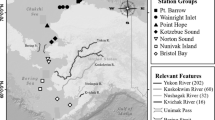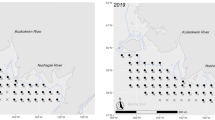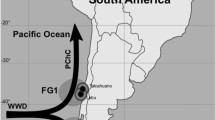Abstract
Electrona antarctica and Bathylagus antarcticus are dominant fishes in the Southern Ocean pelagic ecosystem with disparate life histories, making them excellent subjects for comparative studies. Twenty-one indices of nutritional condition were compared in both species by observing changes in each index as it varied spatially and temporally in association with the marginal ice-zone bloom in the northwestern Weddell Sea. E. antarctica and B. antarcticus exhibited very different patterns of response to the bloom. Nutritional condition increased in 11 of 21 measures in E. antarctica, suggesting that it was in poorer condition at ice-covered stations and in greatly improved condition in post-bloom, open-water stations. The data, combined with a few observations of larvae, indicate that E. antarctica increases feeding before the spring bloom, rapidly building stores of lipid, which are probably used for spawning. In contrast, only three measures of condition were variable in B. antarcticus, and lipid actually decreased from ice-covered to open water. RNA:DNA values increased in open water, coinciding with an increase in food volume present in their guts. These observations, coupled with observations of larvae in ice-covered stations, suggest that B. antarcticus possesses sufficient energetic stores to spawn prior to the bloom, so that larvae are able to fully utilize available resources associated with the spring bloom. Increased somatic growth, as indicated by RNA:DNA, may not begin until later, when the bloom was beginning to decline. Earlier work, which suggested that the deeper living, non-migrating species, like B. antarcticus, would not be affected by the bloom until after shallower, migratory species, like E. antarctica, is supported. Of the assays tested, RNA:DNA appeared to be the most sensitive. The combined assessment of many measures including biochemical, compositional, dietary, and age estimates from single specimens is possible if the samples are treated with sufficient care. The reliance upon a single measure to help interpret the ecology of a species, especially in nekton-sized species, is not as effective as techniques used in combination.
Similar content being viewed by others
Author information
Authors and Affiliations
Additional information
Received: 12 January 2000 / Accepted: 16 August 2000
Rights and permissions
About this article
Cite this article
Geiger, S., Donnelly, J. & Torres, J. Effect of the receding ice-edge on the condition of mid-water fishes in the northwestern Weddell Sea: results from biochemical assays with notes on diet. Marine Biology 137, 1091–1104 (2000). https://doi.org/10.1007/s002270000428
Issue Date:
DOI: https://doi.org/10.1007/s002270000428




